-

人教版高中英语必修3Healthy Eating说课稿4篇
Language learning needs a context, which can help the learners to understand the language and then can product comprehensible output, so computer has the advantages to make the materials attractive.Part 3 Learning MethodsTask-based, self-dependent and cooperative learningPart 4 Teaching ProcedureStep One Lead-in“Interest is the best teacher.” Therefore, at the very beginning of the class, I should spark the students’ mind to focus on the centre topic “the band”. I’ll show some pictures of food to attract their attention and then bring some questions.Question:What kind of food they like?What should go into a good meal?The answers must relate to the diet. After this, the students will be eager to know something about a balance diet and this is the very time to naturally lead the class into Step 2Step 2 Reading for information: skimming and scanning In this step, I use Task-based Language Teaching method, which can give students a clear and specific purpose while skimming and scanning the context.Task 1 General ideaThe students will be asked to just glance at the title and the pictures of the passage, and then guess what they will read in the text. And they’ll be divided into groups of four to have a discussion.The purpose is to inspire the students to read actively, not passively. In addition, the task is to develop the students’ reading skill by making prediction and to encourage the students to express their thoughts in English and cooperate with each other.Task 2 Main idea of each paragraphCooperative learning can raise the students’ interest and create an atmosphere of achievement. Based on this theory, I divide the whole class into 4 groups to skim the whole text and get the main idea of each paragraph.

人教版高中英语必修4Working The Land说课稿3篇
Knowledge objectives:(1) to make Ss grasp the usage of words, expressions and sentence structures: statistics, struggle, thanks to, rid of, some patterns for persuasion, the “ing” form as subject and object;(2)to use learnt knowledge to persuade sb.Ability objectives:(1) to develop Ss’ reading skills(skimming, scanning, word guessing);(2) to improve Ss’ speaking, communicating and cooperating skills.Emotional objectives:to make Ss know the contribution of Yuan,and learn his spirit and his simple life time.Teaching important and difficult points:(1) some words, expressions and sentence structures mentioned above;(2)the content of the text;(3)training their reading and speaking skills.Teaching methods: CLT, TBLT,QT.Learning strategies: CLS, QLS, TBLS.Teaching procedures:Step 1 lead-in: (1) teacher plays a piece of recent news from CCTV about the harvest of the super hybrid rice, and ask students whether they know Yuan or not, and talk about him and his contribution.(2)Brain storm: let Ss describe Yuan in their minds including his appearance, his living condition and so on.Step 2 fast reading tasks:(1)teacher introduces Yuan and super hybrid rice(2)make Ss read the text as fast as possible with questions. Such as: what’s the general ideaof this passage? What’s Yuan’ dream? (skimming and scanning skill)Step 3 intensive reading tasks(1)let Ss read the text silently, find topic sentence of each paragraph and draw the difficult sentences and the knowledge what they don’t understand.(words guessing)(2)teacher and Ss talk about the important words, expressions and sentences together, and ask Ss to retell the content of the text.(summarizing and paraphrasing)(3)teacher summarize this part.(4) read again following the courseware.

人教版高中英语必修5First aid说课稿6篇
In this class, I have 3 teaching aims, that is, knowledge aims, ability aims and emotion aims.1) Knowledge-Teach students new words and expressions, such as temporary, bleed,sprain choke, first aid, fall ill and so on.-Enable students to have a better understanding for some basic knowledge of first aid.2) Ability-Train students’ speaking, reading and writing abilities by different teaching activities, such as skimming, comprehending, team work, role play, retelling and writing.-Develop students’ reading strategy on how to move general idea to specific information.3) Emotion-Promote students’ awareness of giving first aid.- Cultivate students’ creativities.Then let’s come to my teaching methods and activities.III. Teaching methods and activities:To achieve different teaching aims, various kinds of teaching methods and activities will be adopted throughout this period, such as TBL (task-based learning), skimming, team work, brainstorm and others, which can offer students opportunities to fulfill tasks in which they can use language to achieve a specific outcome.IV. Teaching aids:Computer and blackboardV. Teaching important points:1) Make students have a clear mind for the structure of the text.2) Help students understand the theme of the text.VI. Teaching difficulties:1) So many new words may affect students’ understanding.2) How to get students to know about the functions of the skin and thecauses, characteristics and treatments for different degree burns,and the knowledge about giving first aid. VII. Blackboard design:

人教版高中英语必修5Great scientists说课稿4篇
通过写文章梗概,培养学生综合运用语言的能力,学习用恰当的英语描述科学家的故事。这是本课的教学难点。教师可以使用完形填空的方式来帮助学生整理语篇,从而来降低难度。本课的教学重点的突破方法是:在阅读前,让学生初步了解得出科学观点所需要的基本程序,从而轻松而自然地导入文章的阅读;在阅读过程中,由易到难设计快速阅读和精读的问题,层层推进各种阅读活动,让学生对阅读内容从整体感知到细节理解,最后深层读懂整篇文章,同时加强阅读策略的指导,让每个学生都主动参与课堂教学活动,最终达到提高阅读能力的目的。Step 4 Post-readingGroup Activities四人小组共同合作,在老师的适当指导下,就以下2个问题展开讨论,让学生就所知、所学、所感和所想融入话题,然后抽若干同学代表作小组发言。1. What do you think about John Snow, and what should we learn from him?2. Cholera was 19th century disease, which two diseases are similar to cholera today? Why?

人教版高中英语必修5Making the news说课稿4篇
今天我们来介绍一下必修五第四单元的授课方式。这个单元的题目是Making the news。应该是学生比较感兴趣的话题,学生往往对新闻工作充满好奇,所以我们可以利用这个机会多设计一些师生互动和学生互动,来激发起学习的积极性,提高学习效率。同时我们可以利用这个单元不仅帮助学生掌握语言知识,培养语言能力,同时让其了解新闻工作的重要性,培养起社会智能感。这个单元分为六个课时,它的教学目标是这样的:语言目标是掌握词汇表中的常用单词和短语,掌握倒装句的一些基本用法。 技能目标是能初步掌握约会的基本句型并在真实的场景下正确运用。新闻报道类文章的写作技能。采访的基本规范和沟通技能。情感目标是对新闻报道的客观性和真实性有更好的理解。对新闻记者的职业有更深入的了解,并能体会其工作的重要性。下面我们来介绍一下第一课时的授课方式,第一课的教学目标是这样的第一课时的教学目标语言目标:单词:Occupation, journalist, editor, photographer, curious, personality, enthusiasm

人教版高中英语必修5The United Kingdom说课稿4篇
Teaching Aims:Knowledge 1. Get the students to learn the useful new words and expressions in this section. Aims:2. Let the students learn about how the UK was formed and the four groups of invaders.1. Develop students’ reading ability and let them learn different Ability reading skills. Aims:2. Enable students to learn to talk about the United Kingdom and the Union Jack Emotional 1. Let students know more about the UK2. Develop students’ sense of cooperative learning Aims:Teaching Important Points:1. Let the students learn about the countries of the United Kingdom and the Union Jack2. Get the students to read the passage and know about how the UK was formed and the four groups of invaders.3. Have the students learn different reading skills.Teaching Difficult Ponts:1. Develop students’ reading ability.2. Enable students to talk about the United Kingdom and the Union Jack.3. Let students learn how the UK was formed geographically and historically.Teaching Methods:Showing pictures, asking, exercising, listening, reading etc.Teaching Aids:A computer,a projector and a blackboard.Teaching Procedures: 1) Show a map of the world, ask students the following questions:Where is the UK?What’s the full name of the UK?2) Ask the students work in pairs to do the quiz on Page 9.Do you want to test how many things you know about the United Kingdom? Let’s have a small test.Using the map on P9, students answer the following questions:?How many countries does the UK consist of? What are they??England is divided into three main areas. Do you know what they are? 1) Scanning (10Minutes )Let the students hold the questions asked in pre-reading and read the passagequickly and then let them do the following exercise.Join lines to the right answer.
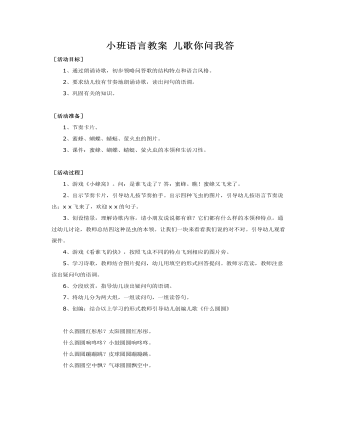
小班语言教案 儿歌你问我答
[活动准备]1、节奏卡片。2、蜜蜂、蝴蝶、蜻蜓、萤火虫的图片。3、课件:蜜蜂、蝴蝶、蜻蜓、萤火虫的本领和生活习性。 [活动过程]1、游戏《小蜂窝》。问:是谁飞走了?答:蜜蜂。瞧!蜜蜂又飞来了。2、出示节奏卡片,引导幼儿按节奏拍手。出示四种飞虫的图片,引导幼儿按语言节奏说出:x x飞来了,欢迎x x的句子。3、创设情景,理解诗歌内容。请小朋友说说都有谁?它们都有什么样的本领和特点。通过幼儿讨论,教师总结四这种昆虫的本领。让我们一块来看看我们说的对不对。引导幼儿观看课件。
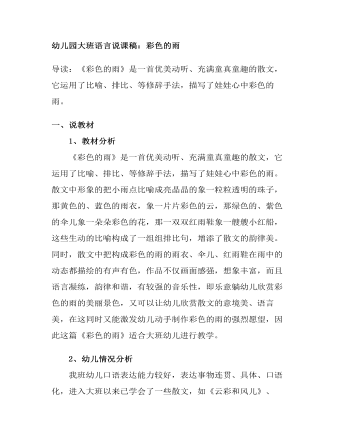
幼儿园大班语言说课稿
一、说教材 1、教材分析 《彩色的雨》是一首优美动听、充满童真童趣的散文,它运用了比喻、排比、等修辞手法,描写了娃娃心中彩色的雨。散文中形象的把小雨点比喻成亮晶晶的象一粒粒透明的珠子,那黄色的、蓝色的雨衣,象一片片彩色的云,那绿色的、紫色的伞儿象一朵朵彩色的花,那一双双红雨鞋象一艘艘小红船,这些生动的比喻构成了一组组排比句,增添了散文的韵律美。同时,散文中把构成彩色的雨的雨衣、伞儿、红雨鞋在雨中的动态都描绘的有声有色,作品不仅画面感强,想象丰富,而且语言凝练,韵律和谐,有较强的音乐性,即乐意躺幼儿欣赏彩色的雨的美丽景色,又可以让幼儿欣赏散文的意境美、语言美,在这同时又能激发幼儿动手制作彩色的雨的强烈愿望,因此这篇《彩色的雨》适合大班幼儿进行教学。
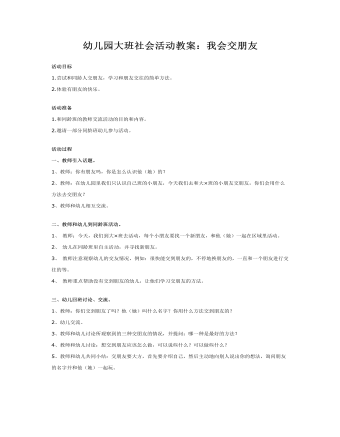
幼儿园大班社会活动教案:我会交朋友
活动准备 1.和同龄班的教师交流活动的目的和内容。 2.邀请一部分同龄班幼儿参与活动。活动过程 一、教师引入话题。 1、教师:你有朋友吗,你是怎么认识他(她)的? 2、教师:在幼儿园里我们只认识自己班的小朋友,今天我们去和大×班的小朋友交朋友,你们会用什么方法去交朋友? 3、教师和幼儿相互交流。
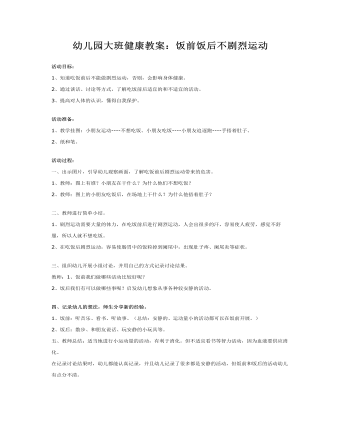
幼儿园大班健康教案:饭前饭后不剧烈运动
活动准备: 1、教学挂图:小朋友运动----不想吃饭。小朋友吃饭----小朋友追逐跑----手捂着肚子。 2、纸和笔。 活动过程: 一、出示图片,引导幼儿观察画面,了解吃饭前后剧烈运动带来的危害。 1、教师:图上有谁?小朋友在干什么?为什么他们不想吃饭? 2、教师:图上的小朋友吃饭后,在场地上干什么?为什么他捂着肚子? 二、教师进行简单小结。 1、剧烈运动需要大量的体力,在吃饭前后进行剧烈运动,人会出很多的汗,容易使人疲劳,感觉不舒服,所以人就不想吃饭。 2、在吃饭后剧烈运动,容易使肠胃中的饭粒掉到阑尾中,出现肚子疼、阑尾炎等症状。
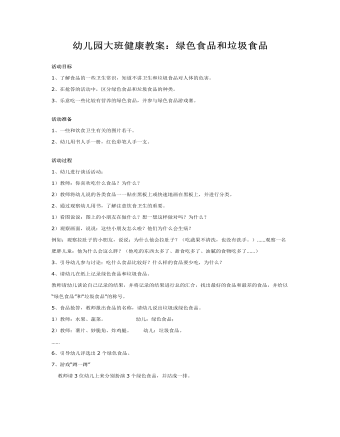
幼儿园大班健康教案:绿色食品和垃圾食品
活动准备 1、一些和饮食卫生有关的图片若干。 2、幼儿用书人手一册,红色彩笔人手一支。活动过程 1、幼儿进行谈话活动: 1)教师:你喜欢吃什么食品?为什么? 2)教师将幼儿说的各类食品一一贴在黑板上或快速地画在黑板上,并进行分类。 2、通过观察幼儿用书,了解注意饮食卫生的重要。 1)看图说说:图上的小朋友在做什么?想一想这样做对吗?为什么? 2)观察画面,说说:这些小朋友怎么啦?他们为什么会生病? 例如:观察拉肚子的小朋友,说说:为什么他会拉肚子?(吃蔬果不清洗,也没有洗手。)……观察一名肥胖儿童:他为什么会这么胖?(他吃的东西太多了、甜食吃多了、油腻的食物吃多了……)
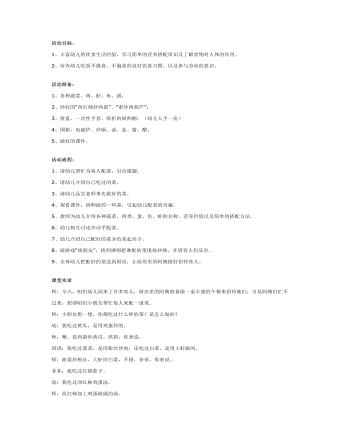
幼儿园大班健康教案:我是厨房小帮手
活动准备: 1、各种蔬菜、肉、虾、鱼、蛋; 2、炒好的“西红柿炒鸡蛋”、“素炒西葫芦”; 3、拼盘、一次性手套、纸折的厨师帽;(幼儿人手一份) 4、围裙、电磁炉、炒锅、油、盐、酱、醋。 5、做好的课件。 活动流程: 1、请幼儿帮忙为客人配菜,引出课题。 2、请幼儿介绍自己吃过的菜。 3、请幼儿品尝老师事先做好的菜。 4、观看课件:厨师做的一些菜,引起幼儿配菜的兴趣。 5、教师为幼儿介绍各种蔬菜、肉类、蛋、鱼、虾的名称、营养价值以及简单的搭配方法。 6、幼儿相互讨论并动手配菜。 7、幼儿介绍自己配好的菜并给菜起名字。 8、做游戏“找朋友”,找到谁则把谁配的菜现场炒熟,并请客人们品尝。 9、全体幼儿把配好的菜送到厨房,让厨房里的阿姨做好招待客人。
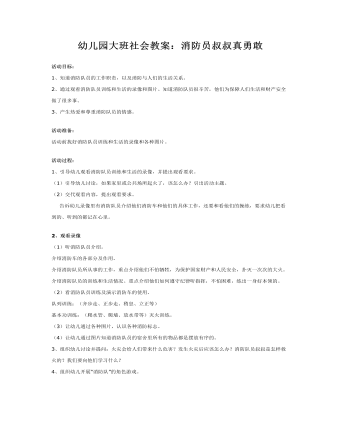
幼儿园大班社会教案:消防员叔叔真勇敢
活动准备:活动前找好消防队员训练和生活的录像和各种图片。活动过程: 1、引导幼儿观看消防队员训练和生活的录像,并提出观看要求。 (1)引导幼儿讨论,如果家里或公共场所起火了,该怎么办?引出活动主题。 (2)交代观看内容,提出观看要求。 告诉幼儿录像里有消防队员介绍他们消防车和他们的具体工作,还要和看他们的操练,要求幼儿把看到的、听到的都记在心里。2、观看录像 (1)听消防队员介绍。 介绍消防车的各部分及作用。 介绍消防队员所从事的工作,重点介绍他们不怕牺牲,为保护国家财产和人民安全,扑灭一次次的大火。 介绍消防队员的训练和生活情况。重点介绍他们如何遵守纪律听指挥,不怕困难,练出一身好本领的。
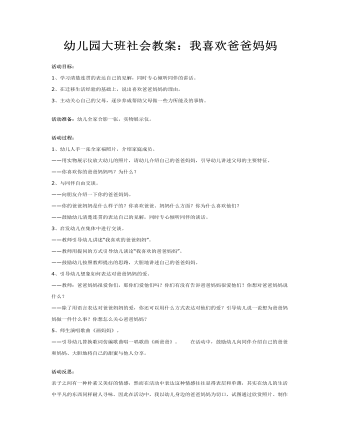
幼儿园大班社会教案:我喜欢爸爸妈妈
活动准备:幼儿全家合影一张,实物展示仪。活动过程:1、幼儿人手一张全家福照片,介绍家庭成员。——用实物展示仪放大幼儿的照片,请幼儿介绍自己的爸爸妈妈,引导幼儿讲述父母的主要特征。——你喜欢你的爸爸妈妈吗?为什么?2、与同伴自由交谈。——向朋友介绍一下你的爸爸妈妈。——你的爸爸妈妈是什么样子的?你喜欢爸爸、妈妈什么方面?你为什么喜欢他们?——鼓励幼儿清楚连贯的表达自己的见解,同时专心倾听同伴的谈话。3、启发幼儿在集体中进行交谈。——教师引导幼儿讲述“我喜欢的爸爸妈妈”。——教师用提问的方式引导幼儿谈论“我喜欢的爸爸妈妈”。 ——鼓励幼儿按照教师提出的思路,大胆地讲述自己的爸爸妈妈。
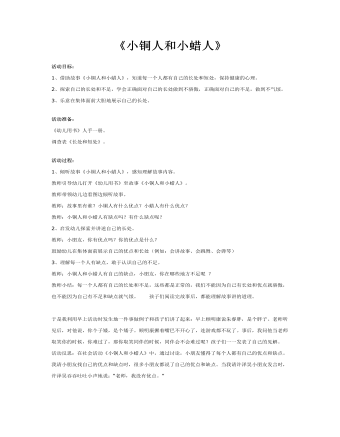
幼儿园大班社会教案:小铜人和小蜡人
活动准备: 《幼儿用书》人手一册。 调查表《长处和短处》。 活动过程: 1、倾听故事《小铜人和小蜡人》,感知理解故事内容。 教师引导幼儿打开《幼儿用书》至故事《小铜人和小蜡人》。 教师带领幼儿边看图边倾听故事。 教师:故事里有谁?小铜人有什么优点?小蜡人有什么优点? 教师:小铜人和小蜡人有缺点吗?有什么缺点呢? 2、启发幼儿探索并讲述自己的长处。 教师:小朋友,你有优点吗?你的优点是什么? 鼓励幼儿在集体面前展示自己的优点和长处(例如:会讲故事、会跳舞、会弹琴)
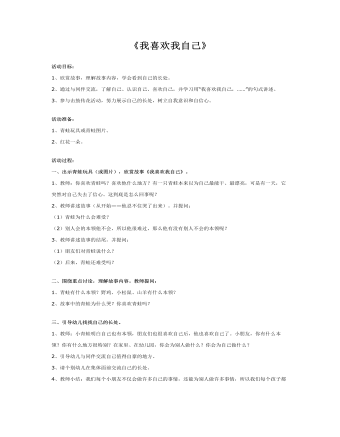
幼儿园大班社会活动教案:喜欢我自己
活动准备: 1、青蛙玩具或青蛙图片。 2、红花一朵。 活动过程: 一、出示青蛙玩具(或图片),欣赏故事《我喜欢我自己》。 1、教师:你喜欢青蛙吗?喜欢他什么地方?有一只青蛙本来以为自己最能干、最漂亮,可是有一天,它突然对自己失去了信心。这到底是怎么回事呢? 2、教师讲述故事(从开始——他忍不住哭了出来)。并提问: (1)青蛙为什么会难受? (2)别人会的本领他不会,所以他很难过,那么他有没有别人不会的本领呢? 3、教师讲述故事的结尾。并提问: (1)朋友们对青蛙说什么? (2)后来,青蛙还难受吗?
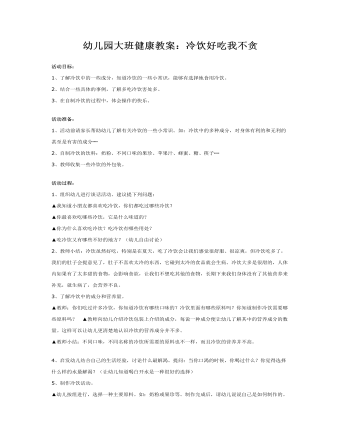
幼儿园大班健康教案:冷饮好吃我不贪
活动准备:1、活动前请家长帮助幼儿了解有关冷饮的一些小常识。如:冷饮中的多种成分,对身体有利的和无利的甚至是有害的成分┉2、自制冷饮的饮料:奶粉、不同口味的果珍、苹果汁、蜂蜜、糖、筷子┉3、教师收集一些冷饮的外包装。 活动过程: 1、组织幼儿进行谈话活动。建议提下列问题: ▲我知道小朋友都喜欢吃冷饮,你们都吃过哪些冷饮? ▲你最喜欢吃哪些冷饮,它是什么味道的? ▲你为什么喜欢吃冷饮?吃冷饮有哪些用处? ▲吃冷饮又有哪些不好的地方?(幼儿自由讨论)
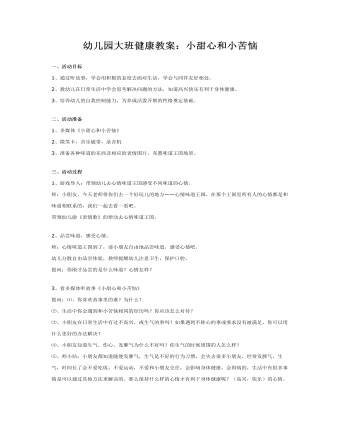
幼儿园大班健康教案:小甜心和小苦恼
二、活动准备 1、多媒体《小甜心和小苦恼》 2、微笑卡,音乐磁带,录音机 3、准备各种味道的东西及相应的表情图片,布置味道王国场景。三、活动过程 1、游戏导入:带领幼儿去心情味道王国感受不同味道的心情。 师:小朋友,今天老师带你们去一个好玩儿的地方——心情味道王国,在那个王国里所有人的心情都是和味道相联系的,我们一起去看一看吧。 带领幼儿做《表情歌》的律动去心情味道王国。2、品尝味道,感受心情。 师:心情味道王国到了,请小朋友自由地品尝味道,感受心情吧。 幼儿分散自由品尝体验,教师提醒幼儿注意卫生,保护口腔。 提问:你刚才品尝的是什么味道?心情怎样?
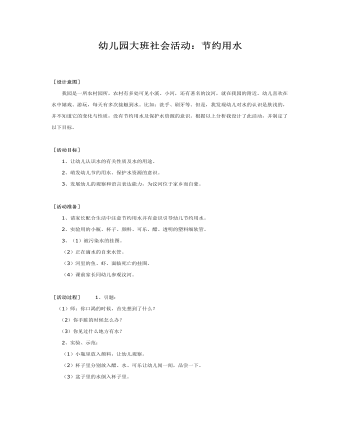
幼儿园大班社会活动教案:节约用水
[活动目标]1、让幼儿认识水的有关性质及水的用途。2、萌发幼儿节约用水、保护水资源的意识。3、发展幼儿的观察和语言表达能力,为汶河位于家乡而自豪。 [活动准备]1、请家长配合生活中注意节约用水并有意识引导幼儿节约用水。2、实验用的小瓶、杯子、颜料、可乐、醋、透明的塑料细软管。3、(1)被污染水的挂图。 (2)正在滴水的自来水管。 (3)河里的鱼、虾、面临死亡的挂图。 (4)课前家长同幼儿参观汶河。

幼儿园大班社会活动教案:超市购物
活动目标: 1、通过实践活动,充分调动幼儿参与的积极性和探究交流的主动性。 2、使幼儿在尝试交流、选择购物中懂得做出决定需要考虑诸多方面问题,并在购物过程中体验交流、选择、合作、分享的快乐。活动准备: 1、活动前一天组织讨论,选择购物区域。 2、具体准备由幼儿与老师一起讨论决定。活动进程:(一)活动前的讨论 1.选择购物区域: 师:明天,我们要去大统华超市购物,因为地方大,而我们的时间有限,只能选择超市中的一个区域,下面请大家讲一讲,超市里有哪些区域? 幼:洗涤用品区,日常用品区,餐具区,儿童食品区,糕点区,蔬菜区…… 师:选择那个区域呢?请小朋友决定。 (教师贴区域名称,准备好粘贴画“苹果娃”,以便幼儿决定后在其名称下贴一标志。) 师:请小朋友说一下作出准备的理由。